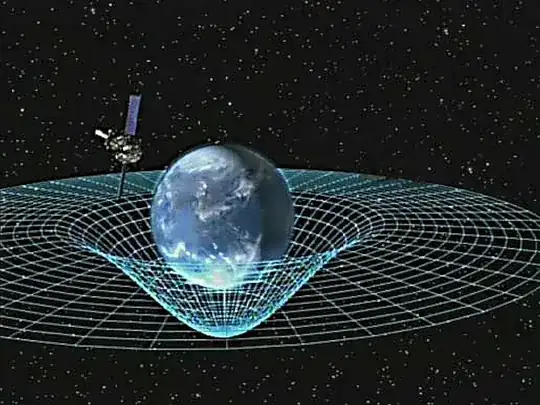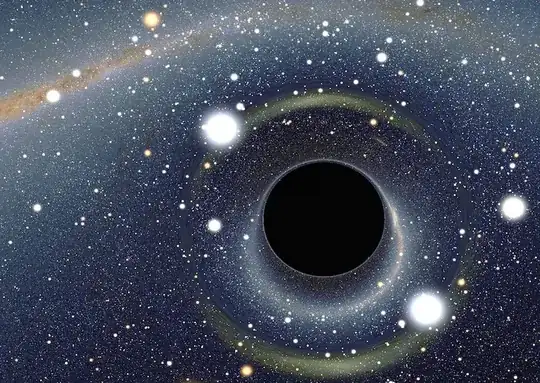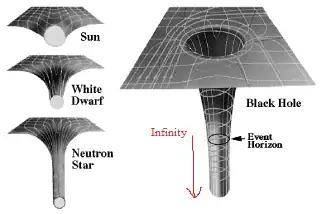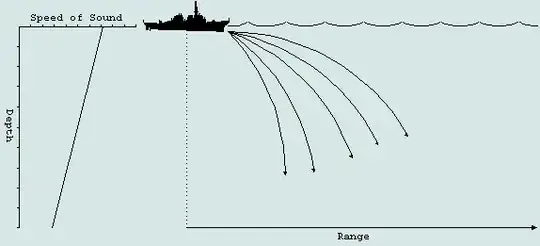Light doesn’t accelerate in a gravitational field, which things with mass would do, because light has a universally constant velocity. Why is that exception?
-
3Light is affected by gravity in general, that's why there's gravitational lensing. Why would gravity from black holes be any different? – Barmar Jan 11 '19 at 16:12
-
11You might be interested in How can gravity affect light?, Why doesn't gravity speed up light? and Speed of light in a gravitational field? on the Physics SE. – John Rennie Jan 11 '19 at 16:28
-
9Title was changed from "Black Holes" to "Gravity", which made the existing comments and answers confusing. – GrumpyCrouton Jan 11 '19 at 19:58
-
5Great, now it's just a bunch of confusing answers. Gravity bends space-time, the medium through which light travels. – Mazura Jan 13 '19 at 23:57
-
1@Mazura I'd formulate it more directly: Gravity IS the bending of space-time – Penguin9 Jan 14 '19 at 05:05
-
5Photons have no rest mass -- they never rest, do they. But each existing photon has the mass which is equivalent to its energy ($m = \frac{E}{c^2}$, or $\frac{\hbar*\nu}{c^2}$). – Peter - Reinstate Monica Jan 14 '19 at 10:15
-
1acceleration on any object by the sun $g = \frac{GM_\odot}{r^2}$ . So, acceleration even in Newtonian Gravity is independent of the mass of the object. – eshaya Apr 03 '22 at 19:41
6 Answers
Another way to answer this question is to apply the Equivalence Principle, which Einstein called his "happiest thought" (so you know it has to be good). The equivalence principle says that if you are in an enclosed box in the presence of what Newton would call a gravitational field, then everything that happens in that box must be the same as if the box was not in a gravitational field, but accelerating upward instead. So when you release a ball, you can imagine the ball is accelerated downward by gravity, or you can imagine everything but the ball is accelerated upward, and the ball is simply being left behind (which, ironically, checks better with the stresses you can easily detect on every object around you that are not present on the ball, including the feeling you are receiving from your bottom right now).
Given that rule, it is easy to see how light would be affected by gravity-- simply imagine shining a laser horizontally. In the "left behind" reference frame, we see what would happen-- the beam would start from a sequentially higher and higher point, and that raising effect is accelerating. So given the finite speed of light, the shape of the beam would appear to curve downward, and the beam would not strike the point on the wall of the box directly opposite the laser. Therefore, this must also be what is perceived from inside the box-- the beam does not strike the point directly across from the laser (as that point is getting higher then the point across from it where the light was emitted), and its path appears to curve downward. Ergo, light "falls."
Indeed, this is the crucial simplification of the Equivalence Principle-- you never need to know what the substance is, all substances "fall the same" because it's nothing happening to the substance, it is just the consequences of being "left behind" by whatever actually does have forces on it and is actually accelerating.
Incidentally, it is interesting to note that even in Newtonian gravity, massless objects would "fall the same" as those with mass, but to see it requires taking a limit. Simply drop a ball in a vacuum, then a lower mass ball, then a lower still mass. All objects fall the same under Newtonian gravity. So simply proceed to the limit of zero mass, you will not see any difference along the path of that limit. Nevertheless, Newtonian gravity doesn't get the answer quite right for the trajectory of light in gravity, because Newtonian physics doesn't treat the speed of light correctly.
- 5,320
- 1
- 13
- 18
-
9Well, Newtonian gravity, $ F = \frac{Gm_1m_2}{r^2}$ certainly goes to zero force when the mass is zero. – Carl Witthoft Jan 11 '19 at 17:25
-
12@CarlWitthoft, F = ma also goes to zero when the mass is zero. Applying zero force to zero mass gives you any acceleration you wish. – Mark Jan 12 '19 at 00:38
-
8I'm torn with this answer... it just explains that light is affected by gravity (by way of a thought experiment, no less). The OP knew that already - he wanted to know why (which is a can of worms, sure...). The equivalence principle is not the reason for the light behaving its way, it is just a didactic helper... – AnoE Jan 12 '19 at 17:12
-
@AnoE : it isn't a can of worms. It's simpler than you think. It seems however that a lot of GR textbooks were written before the Einstein digital papers were online, and don't explain it as simply as Einstein did. – John Duffield Jan 12 '19 at 18:31
-
6@JohnDuffield, ok, my comment was a bit flippant maybe. But in an accepted answer, I would at least like to see curved spacetime mentioned. Or a mention that all massless things always move at the speed of light. Again, the E.P. is a "principle" - it is a thought experiment, not the physical reason for light behaving as it does. – AnoE Jan 12 '19 at 21:04
-
3@AnoE - Newtonian physics had no answer to why gravity apparently acts instantaneously, with the force proportional to the product of the masses divided by the square of the distance. It's an ad hoc explanation. General relativity explains that (and also explains where that Newtonian model falls short), but it does not explain why the speed of light is (locally) constant, nor does it explain what makes space-time curve. Quantum mechanics has similar issues with "why" questions. Physics answers "what" questions. "Why" questions are the purview of metaphysics, philosophy, and religion. – David Hammen Jan 12 '19 at 23:01
-
1I'm not sure one can draw any significant distinction between "didactic helpers" and all of physics. But I think it's fair to say that the equivalence principle is only part of the issue-- it tells you why light "falls the same" as everything else, but by itself it doesn't tell you why anything falls-- for that, you need something that involves the gravitational acceleration in some way. That's where the spacetime curvature comes in, but that's a much harder issue than "why light falls like other things"-- as long as you already know that other things do fall. – Ken G Jan 13 '19 at 07:17
-
@DavidHammen and KenG, good points, that's the direction I wanted to allude to with my comments. (N.B. OP does use the GR tag in his question.) It's interesting to me that a good part of the existing answers (except this one) talk a lot about black holes - OP does not mention black holes, and those are an edge case anyways. I don't feel qualified to write a helpful answer myself, but will keep watching... – AnoE Jan 13 '19 at 11:03
-
@David Hammen : my answer below is correct. Look at those Einstein quotes, I didn't make them up. Science is not a democracy. All the downvotes in the world won't make a right answer wrong, or vice versa. – John Duffield Jan 13 '19 at 16:38
-
@AnoE : there's no problem in mentioning curved spacetime provided you don't say light follows the curvature of spacetime. And there's no harm saying massless things move at the speed of light, provided you don't say the speed of light is constant. Einstein was clear about why light curved - because the speed of light is spatially variable. As for the equivalence principle, yes, it isn't the physical reason for light behaving as it does. In fact it's something of a myth. I've written about it, see this. – John Duffield Jan 13 '19 at 16:44
-
I was confused by you "bottom" comment till Irealised that you were a physicist and that my "bottom" was the underneath of my feet (am reading this standing up!) – Araucaria - Not here any more. Jan 14 '19 at 00:53
-
-
Note that we probably can't ever explain why light is affected by gravity. We can explain how GR predicts that light will bend in the presence of massive objects, and as far as we can tell, it seems that light bends exactly as much as GR says it will. But we have no proof that GR is the truth, and even if GR were the truth, we probably never would have any proof. This is how scientific theories work in general. – Arthur Jan 14 '19 at 09:40
There are a couple of ways one could approach your question:
Black holes are regions of space that have been deformed by a sufficiently concentrated mass. Light waves/particles always travel in a straight line at a constant velocity ($c$). Although a photon approaching a black hole will continue traveling in a straight line through space, space itself has curved so the photon's path will curve.
While photons don't speed up in the presence of a gravity well, they are affected by it in other ways. In specific, photons entering a gravity well are blue-shifted while photons leaving one are red-shifted. This red/blue-shifting happens because time passes slower within a gravity well than without. In all frames of reference, though, the speed of light remains constant. There's more info on this on the wiki.
Note: The question originally referred specifically to black holes. The above hold for any concentration of matter (of which black holes are an extreme example).
- 1,189
- 10
- 15
-
Alex - I removed "black hole" from the title -- just in case some other commentor complains about that. – Carl Witthoft Jan 11 '19 at 17:23
-
2"In all frames of reference, though, the speed of light remains constant." Well, all inertial frames of reference anyway, locally anyway. – Shufflepants Jan 11 '19 at 18:46
-
1Adding to Shufflepants comment, the speed of light is constant locally. If a beam of light approaching a black hole was observed from a sufficiently far away distance, the beam would appear to be slowing down, since time would be passing slower in the gravity well around the black hole. – rcgldr Jan 13 '19 at 17:08
-
@rcgldr, Shufflepants Quite true; I simplified it a bit. Things tend to get a bit messy in the presence of deep gravity wells. – Alex Hajnal Jan 14 '19 at 05:50
-
1Photons travel in straight lines through curved space-time, not space. – ProfRob Apr 18 '19 at 16:51
TL;DR: Light is affected by gravity because it travels along the space-time grid and its curvature which IS gravity. This gets very visible in black holes.
Long Answer:
Black holes are black because no light that crosses the "Event Horizon" can escape ever again. Mass bends the "grid" of space-time. Light - 2-dimensionally speaking - travels along the floor of the space-time grid and follows its curvature i.e. it goes down a cone created by a presence of mass, and moves along the shortest path outwards again. This makes the journey of the light take longer. Now for a black hole things are more extreme: A black hole forms, when a lot of matter is crammed into a space that is at or smaller than the Schwarzschild Radius. The Schwarzschild Radius of any stellar object is determined solely by its mass. Any mass with a high enough denisty turns into a black hole:
$$\mathrm{r_s = \frac{2GM}{c^2}}$$
where $\mathrm{G}$ is Gravitational constant
$\mathrm{M}$ = Mass of object
$\mathrm{c}$ = Speed of light
To understand however how black holes curve space so much that they let no light escape, we must look at only a small part of Schwarzschild's equation: \begin{align} -(1-\frac{r_s}{r})\mathrm{d}t^2 + \frac{1}{1-\frac{r_s}{r}}\mathrm{d}r^2+r^2\mathrm{d}\Omega^2 \end{align}
To paint an image for understanding black holes, we only need this middle section: \begin{align} \frac{\mathrm{d}r^2}{1-\frac{r_s}{r}} \end{align}
Where r is the radius of the stellar object. When r becomes as small as rs, you get a singularity[note] and weird stuff starts happening, most importantly to OPs question, the space-time curvature at the black hole becomes infinite(!), this means that any light that intersects the event horizon at any point will take an infinite amount of time to travel across the black holes funnel.
Here are some extra visualizations:
Gravity space-time cone of earth:

Gravity space-time funnel of a black hole:

(source: interestingengineering.com)

[Note]: Singularity: A singularity is basically, in calculus/algebra terms, just when you divide by zero. A 2D singularity might just look like this: $\mathrm{f(x) = 1/x}$ (the singularity is there in the middle at $\mathrm{x=0}$).
 A 3D singularity can look like this /, singularity at $\mathrm{x=1}$ (this is Riemann's zeta function).
A 3D singularity can look like this /, singularity at $\mathrm{x=1}$ (this is Riemann's zeta function).
- 4,452
- 1
- 16
- 45
- 138
- 6
-
1There is no infinite curvature at the event horizon, only a coordinate singularity. – ProfRob May 02 '22 at 19:32
-
What do you mean with "there is no infinite curvature", the funnel just stops right after the event horizon? As far as I understand (and I don't), it just gets too funnely for c at the event horizon – Penguin9 Jul 03 '22 at 13:36
-
BTW, you can write equations using MathJax on this site. See https://physics.stackexchange.com/help/notation & https://math.stackexchange.com/help/notation – PM 2Ring Jul 03 '22 at 15:21
-
There's some good info in this answer, but also some stuff that's not quite right. Eg, "set theory teaches us: any subset of infinity is also infinite". That's not true: infinite sets have both finite and infinite subsets. As ProfRob says, there's a coordinate singularity at the EH (event horizon) if you use Schwarzschild coordinates, which means that to the Schwarzschild observer it takes infinite time for anything (including light) just to cross the EH, so you can't really use Schwarzschild t to talk about what happens after something crosses the EH. – PM 2Ring Jul 03 '22 at 15:37
-
BTW, a photon going towards a BH is doomed once it crosses the photon sphere at $\frac32r_s$, as discussed in this recent question on our sister site: https://physics.stackexchange.com/q/715922/123208 – PM 2Ring Jul 03 '22 at 15:41
-
Interestingly light or photons do not (according to theory) have “rest mass” ie no mass at rest. But when it is moving (photons are never at rest) they do have mass given by
E = mc2 = hν ⇒ m = E/c2 = hν/c2=h/cλ
- 193
- 1
- 6
-
As it’s currently written, your answer is unclear. Please [edit] to add additional details that will help others understand how this addresses the question asked. You can find more information on how to write good answers in the help center. – Community May 02 '22 at 20:41
Acceleration is not relevant here. Any given gravity well has a definable escape velocity. Particles faster then that velocity escape the well, particles slower do not. The very definition of a black hole is a gravity well (hole) where the escape velocity exceeds 'c' the speed of light particles, so by definition, light can not escape from the hole, making it 'black'.
- 135
- 4
-
2I don't think that's what the OP was asking - more along the lines of "why gravitational lensing?" – Carl Witthoft Jan 11 '19 at 17:25
-
-
-
@ProfRob - perhaps you would care to offer a more succinct definition of a black hole? – Paul Smith May 03 '22 at 22:37
If light has no mass, why is it affected by gravity?
Because light has a wave nature, and a gravitational field is a place where the speed of light varies. So light curves downwards. It's rather like the way sonar waves tend to curve downwards in the sea:
Image from FAS and the US Navy, see course ES310 chapter 20
Light doesn’t speed up its acceleration, which things with mass would do, because light has a universally constant velocity. Why is that exception?
That's not right I'm afraid. See what Einstein said:
1912: “On the other hand I am of the view that the principle of the constancy of the velocity of light can be maintained only insofar as one restricts oneself to spatio-temporal regions of constant gravitational potential”.
1913: “I arrived at the result that the velocity of light is not to be regarded as independent of the gravitational potential. Thus the principle of the constancy of the velocity of light is incompatible with the equivalence hypothesis”.
1914: “In the case where we drop the postulate of the constancy of the velocity of light, there exists, a priori, no privileged coordinate systems.”
1915: “the writer of these lines is of the opinion that the theory of relativity is still in need of generalization, in the sense that the principle of the constancy of the velocity of light is to be abandoned”.
1916: “In the second place our result shows that, according to the general theory of relativity, the law of the constancy of the velocity of light in vacuo, which constitutes one of the two fundamental assumptions in the special theory of relativity and to which we have already frequently referred, cannot claim any unlimited validity”.
1920: “Second, this consequence shows that the law of the constancy of the speed of light no longer holds, according to the general theory of relativity, in spaces that have gravitational fields. As a simple geometric consideration shows, the curvature of light rays occurs only in spaces where the speed of light is spatially variable”.
Einstein also spoke of “the refraction of light rays by the gravitational field”. So did Newton, see Opticks query 20: “Doth not this aethereal medium in passing out of water, glass, crystal, and other compact and dense bodies in empty spaces, grow denser and denser by degrees, and by that means refract the rays of light not in a point, but by bending them gradually in curve lines?” It really is a refraction, and gravitational lensing is an appropriate phrase. Also see the GR section of Is The Speed of Light Everywhere the Same? It’s a PhysicsFAQ article by editor Don Koks. He talks about Einstein and refraction, and says this: "light speeds up as it ascends from floor to ceiling, and it slows down as it descends from ceiling to floor; it's not like a ball that slows on the way up and goes faster on the way down". Isn't that interesting?
A lot of people will tell you that light curves "because it follows the curvature of spacetime", but that isn't right either. Spacetime curvature is associated with the tidal force, not the force of gravity. See my "physics detective" articles on the speed of light and how gravity works for details and references.
- 2,539
- 10
- 19
-
Would the downvoters like to explain why they think Einstein, Newton, and Koks were all wrong? – John Duffield Jan 13 '19 at 16:46
-
12More importantly, would the upvoter care to explain that up-vote? This answer is at best fringy. – David Hammen Jan 14 '19 at 03:03
-
@David Hammen : It isn't fringe. Einstein wasn't wrong, and nor is this answer. Also see Professor Ned Wright's deflection and delay of light: "In a very real sense, the delay experienced by light passing a massive object is responsible for the deflection of the light". – John Duffield Jan 14 '19 at 08:03
-
1your very assumption that sound is an equivalent to light is what's wrong here. – jwenting Jan 14 '19 at 09:16
-
2You tend to confuse the coordinate speed of light, which is just a computational tool but is often regarded as depending on location in a gravitational field, with what any observer would locally measure for the speed of light using their own local ruler and clock. For example, in your link you say " There is no time flowing inside an optical clock, so the height at some location on the plot depicts the real speed of light at that location", but the only thing a physicist can mean by "the real speed of light" is a measurement. Nonunique coordinate systems involve nonunique quantities. – Ken G Jan 14 '19 at 13:15
-
@Ken G : I'm not confusing the speed of light with the coordinate speed of light. Nor did Einstein, or Don Koks. Or Irwin Shapiro, see this: "Because, according to the general theory, the speed of a light wave depends on the strength of the gravitational potential along its path". I'm afraid some of the things you read about general relativity are misleading. That applies to the equivalence principle too, see my essay on that here. – John Duffield Jan 14 '19 at 22:09
-
2You can use whatever quotes you like, the fact is, all local observers will always measure the same c. Any other version of "the speed of light" is a ramification of the chosen coordinates. Coordinate language is not unusual-- we say "time slows down in a gravitational potential" etc.-- but that's also just a coordinate comparison. No observer experiences slowed time-- ever. It's not the invariant. – Ken G Jan 15 '19 at 00:06
-
The downvotes are unjustified. The speed of light is not an absolute constant. Treating it was such is what made special relativity special. To quote wikipedia "In non-inertial frames of reference (gravitationally curved spacetime or accelerated reference frames), the local speed of light is constant and equal to c, but the speed of light along a trajectory of finite length can differ from c, depending on how distances and times are defined". Ask your astronomer friends about the orbit of Mercury and gravitational lensing, or check out how GPS and SatNavs work. – Paul Smith Jan 17 '19 at 16:47
